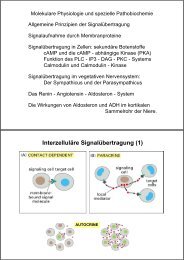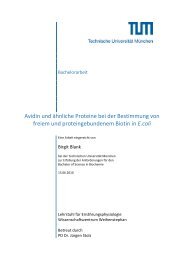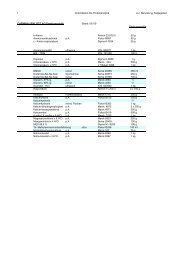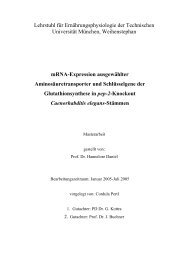Review The role of insulin and IGF-1 signaling in longevity
Review The role of insulin and IGF-1 signaling in longevity
Review The role of insulin and IGF-1 signaling in longevity
Create successful ePaper yourself
Turn your PDF publications into a flip-book with our unique Google optimized e-Paper software.
CMLS, Cell. Mol. Life Sci. Vol. 62, 2005 <strong>Review</strong> Article 333<br />
recognized klotho gene, generat<strong>in</strong>g a strong hypomorphic<br />
klotho allele. Klotho mice (KL –/–), homozygous for<br />
the mutated allele, develop normally for 3–4 weeks, but<br />
then beg<strong>in</strong> to manifest multiple age-related disorders, <strong>in</strong>clud<strong>in</strong>g<br />
<strong>in</strong>fertility, ectopic calcification, lipodystrophy,<br />
sk<strong>in</strong> <strong>and</strong> muscle atrophy, osteoporosis, arteriosclerosis<br />
<strong>and</strong> pulmonary emphysema. Klotho mice die around<br />
2 months <strong>of</strong> age.<br />
Recent studies <strong>in</strong>dicate that the Klotho prote<strong>in</strong> is a novel<br />
s<strong>in</strong>gle-pass transmembrane prote<strong>in</strong>, which is expressed<br />
<strong>in</strong> distal convoluted tubules <strong>of</strong> the kidney <strong>and</strong> the choroid<br />
plexus <strong>of</strong> the bra<strong>in</strong>. <strong>The</strong> molecular mechanism by which<br />
the klotho gene product suppresses the ag<strong>in</strong>g phenotype<br />
is not clear. S<strong>in</strong>gle nucleotide polymorphisms<br />
(SNPs) <strong>in</strong> the human klotho gene have been associated<br />
with altered lifespan [297], <strong>and</strong> associations between<br />
SNPs <strong>in</strong> the human klotho gene <strong>and</strong> coronary artery<br />
disease [298] <strong>and</strong> senile osteoporosis [299, 300], common<br />
age-related disorders <strong>in</strong> humans, have been recently<br />
demonstrated.<br />
As mentioned before, sirtu<strong>in</strong>s extend lifespan <strong>in</strong> yeast <strong>and</strong><br />
worms, <strong>and</strong> it seems that Sir2p <strong>in</strong> yeast plays an essential<br />
regulatory <strong>role</strong> dur<strong>in</strong>g calorie restriction. Extra copies <strong>of</strong><br />
the C. elegans homologue Sir-2.1 extend lifespan <strong>of</strong> wild<br />
type, but not Daf-16 worms, <strong>in</strong>dicat<strong>in</strong>g that <strong>in</strong> worms<br />
Sir-2 requires Daf-16 for <strong>longevity</strong>.<br />
In mammals, Sir2 is represented by seven homologues<br />
[301, 302]. <strong>The</strong> ortholog <strong>of</strong> Sir2, SIRT1, is an NAD-dependent<br />
deacetylase that, <strong>in</strong> addition to histones, also<br />
deacetylates other prote<strong>in</strong>s, <strong>in</strong>clud<strong>in</strong>g MyoD <strong>and</strong> the tumour<br />
suppressor p53 [303–309]. Increased SIRT1 activity<br />
<strong>in</strong> cultured cells reduces p53-mediated apoptosis <strong>in</strong> response<br />
to radiation or oxidative stress. SIRT1 has been<br />
also shown to repress term<strong>in</strong>al differentiation <strong>in</strong> divid<strong>in</strong>g<br />
myocytes [308]. SIRT1 knockout mice have a severe phenotype<br />
with a high degree <strong>of</strong> embryonic <strong>and</strong> postnatal<br />
lethality [309]. However, on outcrossed backgrounds,<br />
some SIRT1 homozygous knockout mice survive to<br />
adulthood. <strong>The</strong>se mice are also smaller than wild type,<br />
sterile, display hyperacetylated p53 <strong>and</strong> show developmental<br />
defects [309].<br />
Recently it was shown that SIRT1 deacetylates <strong>and</strong> represses<br />
the activity <strong>of</strong> the forkhead transcription factor<br />
FOXO3a <strong>and</strong> other mammalian forkhead factors, repress<strong>in</strong>g<br />
their activity [209, 310], opposite to the effect found <strong>in</strong><br />
C. elegans. SIRT1 also reduces forkhead-dependent apoptosis,<br />
<strong>and</strong> this parallels the effect <strong>of</strong> this deacetylase on<br />
p53. Some <strong>in</strong>vestigators have speculated that downregulation<br />
<strong>of</strong> these two classes <strong>of</strong> damage-responsive mammalian<br />
factors may lead to reduced cancer <strong>in</strong>cidence <strong>and</strong><br />
favor a long lifespan under calorie restriction. F<strong>in</strong>ally, regulation<br />
<strong>of</strong> FOXO by SIRT1 may l<strong>in</strong>k this sirtu<strong>in</strong> with forkhead-mediated<br />
metabolic changes <strong>in</strong> mammals, such as<br />
gluconeogenesis, <strong><strong>in</strong>sul<strong>in</strong></strong> secretion/action, lipid usage <strong>and</strong><br />
ketogenesis dur<strong>in</strong>g calorie restriction.<br />
Recent results have shown that mammalian SIRT1 is <strong>in</strong>duced<br />
<strong>in</strong> many tissues <strong>of</strong> calorie-restricted rats, <strong>in</strong>clud<strong>in</strong>g<br />
bra<strong>in</strong>, visceral fat pads, kidney <strong>and</strong> liver [311]. It is also<br />
<strong>in</strong>creased <strong>in</strong> FaO rat hepatoma <strong>and</strong> human 293 cells<br />
treated with serum from calorie restricted rats. Insul<strong>in</strong><br />
<strong>and</strong> <strong>IGF</strong>-1 attenuate this response. SIRT1 <strong>in</strong>hibits stress<strong>in</strong>duced<br />
apoptotic cell death by deacetylat<strong>in</strong>g the DNA<br />
repair factor Ku70, caus<strong>in</strong>g it to sequester the proapoptotic<br />
factor Bax away from mitochondria [311, 312].<br />
Thus, calorie restriction could extend lifespan by promot<strong>in</strong>g<br />
the long-term survival <strong>of</strong> irreplaceable cells.<br />
Humans. Evidence for <strong>in</strong>volvement <strong>of</strong> the <strong><strong>in</strong>sul<strong>in</strong></strong>/<strong>IGF</strong>-1<br />
pathway <strong>in</strong> the control <strong>of</strong> ag<strong>in</strong>g <strong>and</strong> <strong>longevity</strong> <strong>in</strong> humans<br />
is suggestive, but somewhat conflict<strong>in</strong>g, because <strong>of</strong> the<br />
severe metabolic consequences <strong>and</strong> development <strong>of</strong> diabetes<br />
that accompanies deficiency <strong>of</strong> <strong><strong>in</strong>sul<strong>in</strong></strong> or the <strong><strong>in</strong>sul<strong>in</strong></strong><br />
receptor. In humans, <strong><strong>in</strong>sul<strong>in</strong></strong> sensitivity normally decreases<br />
dur<strong>in</strong>g ag<strong>in</strong>g, <strong>and</strong> <strong><strong>in</strong>sul<strong>in</strong></strong> resistance is an important<br />
risk factor [313, 314] for a variety <strong>of</strong> illnesses that<br />
affect morbidity <strong>and</strong> mortality among the elderly [315,<br />
316], <strong>in</strong>clud<strong>in</strong>g hypertension, atherosclerosis, obesity<br />
<strong>and</strong> diabetes.<br />
Interest<strong>in</strong>gly, one <strong>of</strong> the strik<strong>in</strong>g physiological characteristics<br />
recently identified <strong>in</strong> centenarians is their greatly<br />
<strong>in</strong>creased <strong><strong>in</strong>sul<strong>in</strong></strong> sensitivity compared with younger subjects<br />
[317–319]. <strong>The</strong> results <strong>of</strong> the <strong>in</strong>itial study on a limited<br />
number <strong>of</strong> centenarians liv<strong>in</strong>g <strong>in</strong> southern Italy<br />
showed that this group have a preserved glucose tolerance<br />
<strong>and</strong> <strong><strong>in</strong>sul<strong>in</strong></strong> action <strong>and</strong> lower plasma <strong>IGF</strong>-1 levels compared<br />
with aged subjects [319, 320]. More recently, data<br />
from 466 healthy subjects with an age range from 28 to<br />
110 years demonstrated a significant reduction <strong>of</strong> <strong><strong>in</strong>sul<strong>in</strong></strong><br />
resistance <strong>in</strong> subjects from 90 to 100 years old, even after<br />
adjustment for body mass <strong>in</strong>dex (p < 0.010) [321]. <strong>The</strong>se<br />
data <strong>in</strong>dicate that an efficient <strong><strong>in</strong>sul<strong>in</strong></strong> response may have<br />
an impact on human <strong>longevity</strong>, but could also <strong>in</strong>dicate selection<br />
<strong>of</strong> a protected population.<br />
In addition, it has been demonstrated that polymorphic<br />
variants <strong>of</strong> the <strong>IGF</strong>-1 receptor <strong>and</strong> phosphatidyl<strong>in</strong>ositol PI<br />
3-k<strong>in</strong>ase genes can affect <strong>IGF</strong>-1 plasma levels <strong>and</strong> may impact<br />
on human <strong>longevity</strong> [322], <strong>in</strong> particular an A/G polymorphism<br />
at position 3174 (codon 1013) <strong>in</strong> the <strong>IGF</strong>-1 receptor<br />
locus. It has been found that <strong>in</strong>dividuals bear<strong>in</strong>g at<br />
least one A allele at the <strong>IGF</strong>-1R locus have lower plasma<br />
<strong>IGF</strong>-1 levels, <strong>and</strong> this variant is found at an <strong>in</strong>creased proportion<br />
<strong>in</strong> long-lived <strong>in</strong>dividuals. Furthermore, an <strong>in</strong>teraction<br />
between the A allele <strong>of</strong> the <strong>IGF</strong>-1R locus <strong>and</strong> the T allele<br />
at the P I3-k<strong>in</strong>ase (PI3KCB) locus have been shown to<br />
have the lowest <strong>IGF</strong>-1 plasma levels <strong>and</strong> have been also<br />
found among long-lived <strong>in</strong>dividuals. On the other h<strong>and</strong>,<br />
<strong>IGF</strong>-1R mutations have been shown to result <strong>in</strong> <strong>in</strong>trauter<strong>in</strong>e<br />
<strong>and</strong> postnatal growth retardation [323].<br />
As mentioned before, f<strong>in</strong>d<strong>in</strong>gs <strong>in</strong> different organisms are<br />
consistent with the hypothesis that mutations <strong>in</strong> genes <strong>of</strong>









